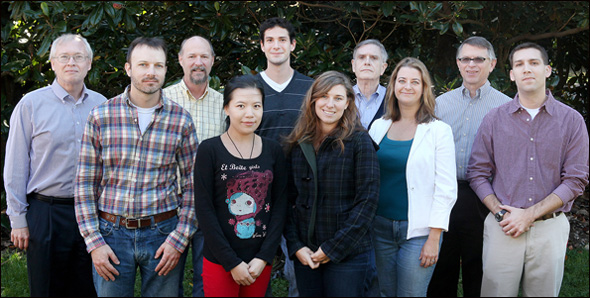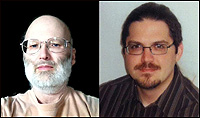
Paper first-authored by engineering graduate student wins IEEE Outstanding Conference Paper Award
As phones and other electronics shrink in size, they’ve grown in capabilities and ubiquitousness.
But, as semiconductors – the omnipresent and indispensable building blocks of the electronics and computer industries – get to the 28 to 45 nanometer feature size (the diameter of a human hair is about 20,000 nanometers), microelectronic devices become more susceptible to malfunction and failure due to solar flares and cosmic ray events in the atmosphere.
Last week NASA scrubbed a launch of an Antares rocket due to unusually high levels of space radiation from the first powerful “X-class” solar flare of 2014, an example of the ways near-Earth space weather can affect human technology.
Of concern are so-called single-event upsets (SEUs), which are the erroneous change of state in a computer memory (SRAMs, DRAMs, etc.) due to interactions with ionizing radiation. The primary concern are particles emanating from solar flares, coronal mass ejections, and galactic cosmic rays. A single well-aimed electron, a fundamental particle that carries electrical charge, can interfere with electronic systems, causing circuit damage or systems to malfunction. Due to rapid advances in microelectronics, this is an area of intense interest.

Electrical engineering graduate student Michael P. King and 22 collaborators, 12 of whom are Vanderbilt School of Engineering faculty researchers, and graduate students in the Radiation Effects and Reliability Group, conclude in a paper published in the mid-December issue of the journal IEEE Transactions on Nuclear Science that electronics designed to operate with ultra-low power likely will exhibit high sensitivity to electron-induced SEUs.
“This represents an additional design concern for both space and terrestrial environments, to avoid unexpectedly high error rates from lightly ionizing particles,” said King, a Ph.D. candidate and first author of the paper, “Electron-Induced Single-Event Upsets in Static Random Access Memory,” which earned the overall Outstanding Conference Paper Award, as well as the Outstanding Student Paper Award, at the 2013 IEEE Nuclear and Space Radiation Effects Conference (NSREC).
“To my knowledge, this the first time that a paper first-authored by a student has won the Outstanding Paper Award at NSREC,” said IEEE Fellow Dan Fleetwood, Olin H. Landreth Professor of Engineering and chair of the Department of Electrical Engineering and Computer Science. “It is quite an achievement for a student paper to be recognized as the most significant work presented at NSREC, which is the leading international conference on radiation effects on microelectronics.”
The researchers presented experimental evidence of SEUs produced by single energetic electrons in 28- and 45-nanometer semiconductors with static random access memory. The word ‘static’ in SRAMs, unlike ‘dynamic’ RAM (DRAM), means the information stored does not need to be periodically refreshed. SRAMs are considered volatile memory in the sense that data persists only while the memory is powered.
“The semiconductor industry continues to scale CMOS (complementary metal-oxide semiconductors) technologies to smaller sizes with reduced operating voltages in pursuit of performance and density goals. Decreasing the device dimensions and operating voltage also reduces the critical charge required to produce a SEU, significantly affecting the sensitivity of memories fabricated in those technology nodes,” King said.
“This team’s research contributes to the understanding of the probability of such events and will help the semiconductor industry forestall and implement mitigation schemes against SEU susceptibility and failure where appropriate,” King said.

In addition to King and Fleetwood, Vanderbilt researchers include Robert Reed and Robert Weller, professors of electrical engineering; Ronald D. Schrimpf, Orrin H. Ingram Professor of Engineering and director of the Institute for Space and Defense Electronics; Marcus Mendenhall, research associate professor of electrical engineering; and Brian D. Sierawski, adjunct assistant professor of electrical engineering; Andrew L. Sternberg, staff engineer, ISDE; Cher Xuan Zhang, post-doctoral Research Scholar; Ph.D. candidates in electrical engineering, Stephanie L. Weeden-Wright and Nelson J. Gaspard; and Elizabeth C. Auden, recent Ph.D. recipient who now works at Sandia National Laboratories.
Six authors are from Broadcom Corporation, a global company that provides semiconductor solutions for wired and wireless communications. They are Balaji Narasimham, Jung K. Wang, Brandon R. Bartz, Daniel S. Reed, Eswara Pitta and Carl A. Monzel. There are three authors from NASA-Goddard Space Flight Center in Greenbelt, Md. They are Melanie D. Berg, Christina M. Seidleck and Jonathan A. Pellish. Robert C. Baumann and Xiaowei Deng are with Texas Instruments.
The Defense Threat Reduction Agency Basic Research Program and the NASA Electronic Parts and Packaging Program supported this research.
King said, “While consumers will appreciate more reliable cellphones or tablets, the real benefit will be felt in technology incorporated into rockets, satellites, exploration spacecraft, aircraft and military systems.”